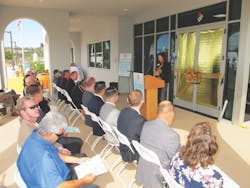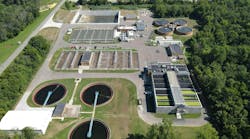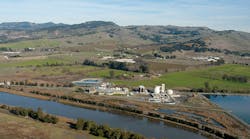Michael Meyer is associate editor for WWD. Meyer can be reached at [email protected] or 847.954.7940.
Oceanside is a scenic city of approximately 175,464 (according to the U.S. Census Bureau’s 2016 estimate) that is located approximately 40 miles north of San Diego on the Pacific Coast of Southern California. The city’s picturesque beaches are popular destinations for vacationers from all over the world, but during the state’s protracted drought from 2011 to 2017, Oceanside residents dealt with water shortages while visitors enjoyed the sand and surf. The drought is officially over, but the city of Oceanside’s conservation efforts continue with the newly opened Mission Basin Groundwater Purification Facility administration building, which has achieved Leadership in Energy and Environmental Design (LEED) Gold certification from the U.S. Green Building Council while helping to provide the city with a reliable source of potable water.
Grappling With Groundwater
The Mission Basin Groundwater Purification Facility began operation in 1992. By desalinating brackish groundwater from the nearby Mission Basin aquifer (part of the larger San Luis Rey Valley groundwater basin), the plant produced 2 million gal per day (mgd); in 2002, the facility’s treatment capacity was expanded to 6.37 mgd. It now provides approximately 15% of Oceanside’s water supply.
After being drawn from a system of eight wells, the brackish water flows through cartridge filters, which remove small particulate matter. The water then is treated with reverse osmosis (RO) in one of the facility’s two treatment trains. Each train includes 48 pressure vessels that contain seven membrane elements, for a total of 336 membrane elements per train. From there, the water passes through granular activated carbon to remove dichloropropane and trichloropropane, and degasifiers to remove hydrogen sulfide and carbon dioxide. Finally, the water is filtered through greensand to remove iron and manganese before distribution to the city’s water supply.
California Gold Rush
Prior to the construction of the administration building, operations at the Mission Basin Groundwater Purification Facility were managed from several modular trailers at the site. Though the trailers originally were proposed as a temporary measure, they remained in place for more than 20 years.
In 2013, the city hired HB&A Architects of Escondido, Calif., to design a new operations building for the site, with the caveat that it must create a structure that would attain LEED Gold certification. It was Oceanside’s first municipal LEED certification effort.
“In order to achieve LEED Gold status, we worked with the owner, design and construction teams to implement sustainable strategies to achieve all LEED prerequisites and a number of LEED optional credit, both throughout the design of the building and during construction,” said Robert Gutierrez, operations manager for the city of Oceanside Water Utilities Department. “Some elements were included in the construction documents, some required data collection throughout construction and some require ongoing commitment on behalf of the owner. Additionally, we calculated anticipated savings of water and energy based upon the occupancy of the building, fixtures and systems designed, and planned operations once complete.”
The design process was completed in early 2015, and construction began later that year. The building was created using 29% recycled material, 17% of which was locally sourced. Additionally, 85% of construction waste from the project was recycled rather than landfilled. Construction was completed in March 2017, and a ceremony celebrating the building’s grand opening was held Nov. 8, 2017.
The new structure includes fixtures that are designed to reduce potable water use by 31% and an irrigation system that reduces outdoor potable water use by 68%. Furthermore, 100% of the space inside the 5,250-sq-ft building has access to quality natural light, which helps reduce the facility’s daily energy usage. In addition, the water utilities department has established policies that promote ongoing sustainable maintenance for the building. In recognition of these efforts, the Mission Basin Groundwater Purification Facility administration building was awarded Gold certification under the LEED for New Construction v2009 rating system.
Building for the Future
The Mission Basin Groundwater Purification Facility is likely to become even more important to Oceanside in coming years. Thanks to the new administration building, the space formerly used by the modular trailers now is available for a prospective expansion of the treatment plant, which may include components for the desalination of seawater drawn from wells near the mouth of the San Luis Rey River. In addition, the city is exploring the environmental feasibility of an indirect potable reuse project to help recharge the Mission Basin aquifer. California’s drought may be over, but Oceanside is intent on finding new ways to be a responsible steward of the environment. The Mission Basin Groundwater Purification Facility is designed to help provide a sustainable future for the city’s residents, come what may.


